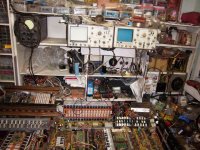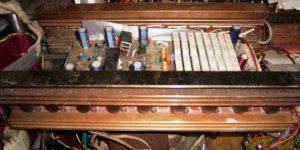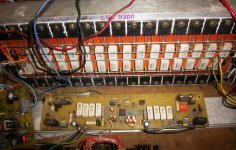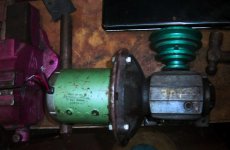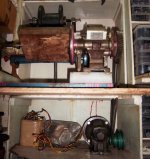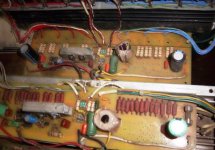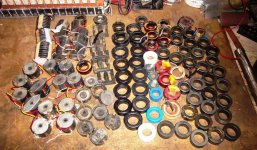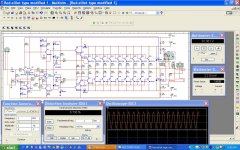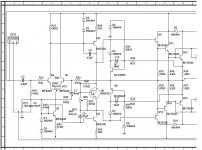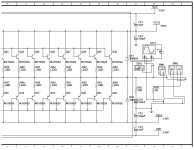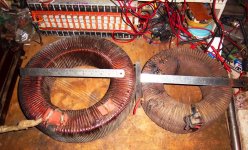Congratulations My Friend, Very Nice Job You Have There Pal, You Have Plenty Of Power Right There !!! Are Those Winding Machines? Homemade Winding Machines?
Cheers.......
Cheers.......
Well thanks Mr. Kimberator,
I bought this winding machine from scrap,rusted and not working condition,Cleaned it ,fitted with2" nylon blocks to increase working height,Aligned it,made a new reel carrier to take the load of 10" and up to 20 kg. reels,fitted with worm geared 30 volt D.C.motor pulley and v belt and paddle speed control and finally painted it.the table top small drill machine is fully made by me apart from d,c, motor and chuck(mouth),made from raw iron rods,plates,cast iron pipes,which I myself cut,worked on lathe machine,welded,grinded,drilled and fittedand finaly painted,my next hardware project is to make a big torroidal winding machine to wind kind of torrid traffos I have previously shown,some more photos of my work
regards to all senior members.
I bought this winding machine from scrap,rusted and not working condition,Cleaned it ,fitted with2" nylon blocks to increase working height,Aligned it,made a new reel carrier to take the load of 10" and up to 20 kg. reels,fitted with worm geared 30 volt D.C.motor pulley and v belt and paddle speed control and finally painted it.the table top small drill machine is fully made by me apart from d,c, motor and chuck(mouth),made from raw iron rods,plates,cast iron pipes,which I myself cut,worked on lathe machine,welded,grinded,drilled and fittedand finaly painted,my next hardware project is to make a big torroidal winding machine to wind kind of torrid traffos I have previously shown,some more photos of my work
regards to all senior members.
Attachments
This Is What I Call "True DIY Spirit", Again Congratulations My Friend, My Brain Almost Fries As I Am Trying To Finish The 1.5Kw @8R Amp.....I'll Let You Know When The Job Is Done....
Best Wishes Mr, Vedmitraa.....
Best Wishes Mr, Vedmitraa.....
Photos of the Multisim file of Rod Elliot modified.Please All the learned seniors correct me if there is any thing wrong in this or if can be modified more,as results in Multisim are showing mentioned results.
VedMitra Sharma
VedMitra Sharma
Attachments
one issue, the input LTP offset adjustment pot, 200ohm, a fixed resistor of say 330ohms per side to the wiper arm makes for a bullet-proof design....should the pot open up in the field, you are sure to loose all your output trannies....
Thanks Mr. Tony,
I am sorry but could not understand your suggestion,as I don't know much theory.Will you be kind enough to post corrected photos or file.I will be gratefull.
Regards
VedMitra Sharma
I am sorry but could not understand your suggestion,as I don't know much theory.Will you be kind enough to post corrected photos or file.I will be gratefull.
Regards
VedMitra Sharma
Yeah, You're About Right Tony But.....
May Be You're About Right, But I Think It Depends On What Quality Pot You're Using, In My Personal Experience There's Nothing Better Than The Use Of Fixed Resistors, But That's Limits The Adjust, Sometimes Necessary, DC Offset, This Is Why I Always Use ALPS Sealed Precision Multiturn Potentiometers, This Way I Can Assure That You Don't Have Any Issues With Pot For Long Time, Or Make Proper Calculations To Get The Right Values With Fixed Resistors.....Just My Point Of View, Best Wishes To Anyone😀😀😀one issue, the input LTP offset adjustment pot, 200ohm, a fixed resistor of say 330ohms per side to the wiper arm makes for a bullet-proof design....should the pot open up in the field, you are sure to use all your output trannies....
Thanks Mr. Tony,
I am sorry but could not understand your suggestion,as I don't know much theory.Will you be kind enough to post corrected photos or file.I will be grateful.
Regards
VedMitra Sharma
you can match the input LTP trannies for hFE.......so that you don't rely on the 200ohm pot for output offset adjustments that much.....
May Be You're About Right, But I Think It Depends On What Quality Pot You're Using, In My Personal Experience There's Nothing Better Than The Use Of Fixed Resistors, But That's Limits The Adjust, Sometimes Necessary, DC Offset, This Is Why I Always Use ALPS Sealed Precision Multiturn Potentiometers, This Way I Can Assure That You Don't Have Any Issues With Pot For Long Time, Or Make Proper Calculations To Get The Right Values With Fixed Resistors.....Just My Point Of View, Best Wishes To Anyone😀😀😀
the cost of potentially losing all of the output trannies alone is reason enough to think of ways to get rid of the pot altogether, matching input LTP's is one of them.....
You won't "lose all of those output trannies" if you lose the offset null pot. But it will put DC - a lot of DC - to the speaker 
The real reason to get rid of the pot is noise. Pots are noisier than any resistor and an input stage is the worst place to put noise.

The real reason to get rid of the pot is noise. Pots are noisier than any resistor and an input stage is the worst place to put noise.
Well, I Don't Remember Any Issue About Open Pot Or Noisy Signal Due To A LTP Pot Anyway..At Least Not In My Amps Designed And Built By Myself, Not A Single Issue On That Particular Matter, For What I've Reading Here Now I Think Is Pure Good Luck....
Okay can't we do this,
First make and Test Amp with pot ,set it after half an hour of full load testing, check again then measure and change the values with fixed resistances.i always try to match hfe of transistors.
First make and Test Amp with pot ,set it after half an hour of full load testing, check again then measure and change the values with fixed resistances.i always try to match hfe of transistors.
3kW into 2r0 requires an output of 109.5Vpk.
Do you really think you amplifier can manage to get that output voltage level when delivering 54.77Apk?
You are in dreamland.
Do you really think you amplifier can manage to get that output voltage level when delivering 54.77Apk?
You are in dreamland.
Is it only the voltage which determines the output, is there no part of current in wattage,If it is so than v x I=w is not correct, what I read up til now is wrong?
Ohm's law required only 2 viarables to get the 3rd, P = E^2/R this is the power equation....in current terms, P = I^2 x R
3kW into 2r0 requires an output of 109.5Vpk.
Do you really think you amplifier can manage to get that output voltage level when delivering 54.77Apk?
You are in dreamland.
😀😀😀😀😀
Fantasy world is so lovely
- Status
- Not open for further replies.
- Home
- Amplifiers
- Solid State
- Has any one built this 1KW amp?
